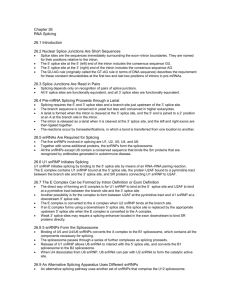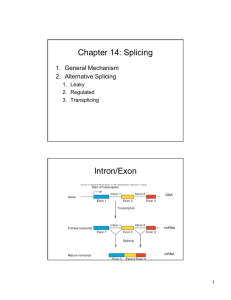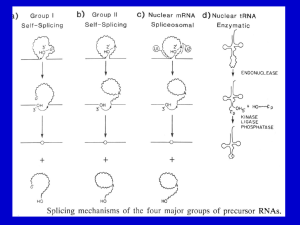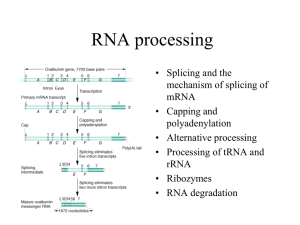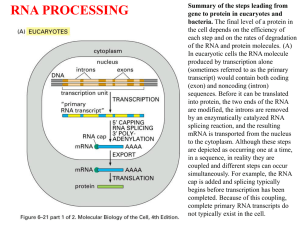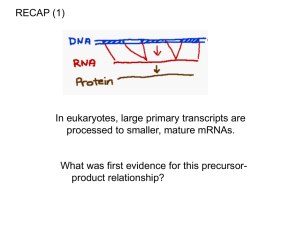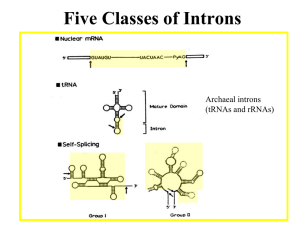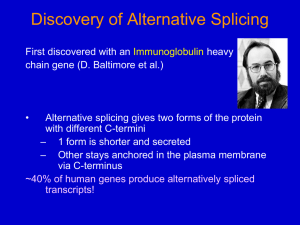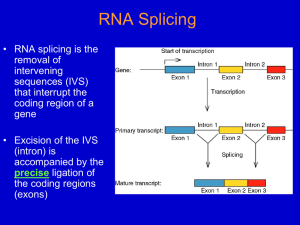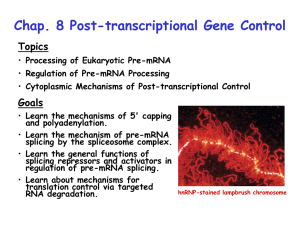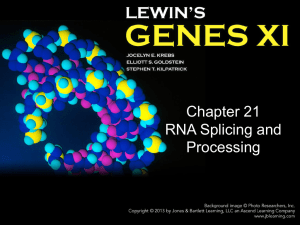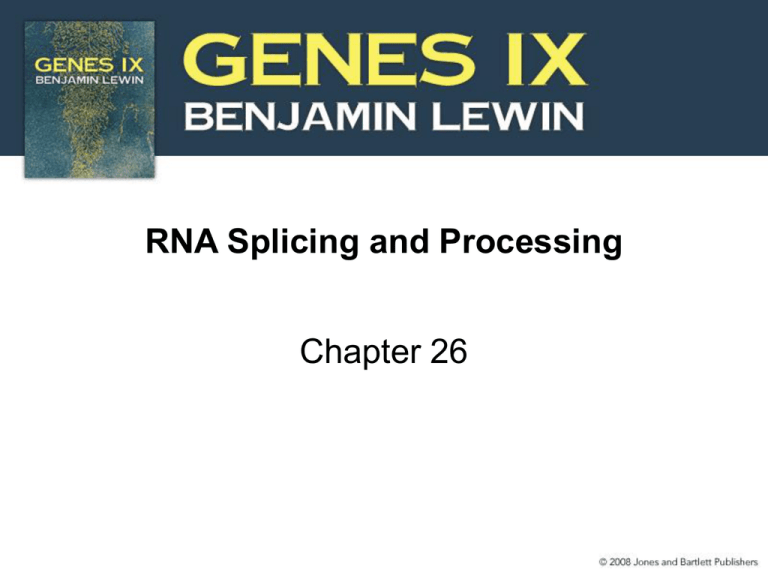
RNA Splicing and Processing
Chapter 26
26.1 Introduction
Figure 26.2
2
26.2 Nuclear Splice Junctions Are Short
Sequences
• Splice sites are the sequences
immediately surrounding the exon–intron
boundaries.
• They are named for their positions relative
to the intron.
3
• The 5′ splice site at the 5′ (left) end of the intron includes the
consensus sequence GU.
• The 3′ splice site at the 3′ (right) end of the intron includes the
consensus sequence AG.
• The GU-AG rule describes the requirement for these constant
dinucleotides at the first two and last two positions of introns in
pre-mRNAs.
Figure 26.3
4
26.3 Splice Junctions Are Read in Pairs
• Splicing depends only on recognition of pairs of splice
junctions.
• All 5′ splice sites are functionally equivalent, and all 3′
splice sites are functionally equivalent.
5
Figure 26.4
26.4 Pre-mRNA Splicing Proceeds through a
Lariat
• Splicing requires the 5′ and 3′ splice sites and a
branch site just upstream of the 3′ splice site.
• The branch sequence is conserved in yeast but
less well conserved in higher eukaryotes.
6
• A lariat is formed when:
– the intron is cleaved at the
5′ splice site
– the 5′ end is joined to a 2′
position at an A at the
branch site in the intron
• The intron is released as
a lariat when:
– it is cleaved at the 3′ splice
site
– the left and right exons are
then ligated together 7
Figure 26.6
• The reactions occur
by transesterifications:
– A bond is transferred
from one location to
another.
Figure 26.7
8
26.5 snRNAs Are Required for Splicing
• The five snRNPs involved in splicing are U1, U2, U5, U4, and
U6.
• Together with some additional proteins, the snRNPs form the
spliceosome.
9
Figure 26.8
• All the snRNPs except U6 contain a conserved
sequence that binds Sm proteins.
– The Sm proteins are recognized by antibodies
generated in autoimmune disease.
10
26.6 U1 snRNP Initiates Splicing
• U1 snRNP initiates
splicing by binding to the
5′ splice site by means of
an RNA–RNA pairing
reaction.
11
Figure 26.9
• The E complex contains:
– U1 snRNP bound at the 5′
splice site
– the protein U2AF bound to a
pyrimidine tract between the
branch site and the 3′ splice
site
– SR proteins connecting U1
snRNP to U2AF
12
Figure 26.10
26.7 The E Complex Can be Formed by
Intron Definition or Exon Definition
• The direct way of forming an E complex is
for:
– U1 snRNP to bind at the 5′ splice site
– U2AF to bind at a pyrimidine tract between
the branch site and the 3′ splice site
• Another possibility is for the complex to
form between:
– U2AF at the pyrimidine tract
– U1 snRNP at a downstream 5′ splice site
13
• The E complex is converted to the A complex
when U2 snRNP binds at the branch site.
• If an E complex forms using a downstream 5′
splice site, this splice site is replaced by the
appropriate upstream 5′ splice site when the E
complex is converted to the A complex.
• Weak 3′ splice sites may require a splicing
enhancer located in the exon downstream to
bind SR proteins directly.
14
26.8 5 snRNPs Form the Spliceosome
• Binding of U5 and U4/U6 snRNPs converts the
A complex to the B1 spliceosome.
– The B1 spliceosome contains all the components
necessary for splicing.
• The spliceosome passes through a series of
further complexes as splicing proceeds.
15
• Release of U1 snRNP:
– allows U6 snRNA to
interact with the 5′ splice
site
– converts the B1
spliceosome to the B2
spliceosome
• When U4 dissociates
from U6 snRNP, U6
snRNA can pair with U2
snRNA to form the
catalytic active site.
16
Figure 26.13
26.9 An Alternative Splicing Apparatus Uses
Different snRNPs
• An alternative splicing pathway uses another set of
snRNPs that comprise the U12 spliceosome.
• The target introns are defined by longer consensus
sequences at the splice junctions.
– They usually include the same GU-AG junctions.
• Some introns have the splice junctions AU-AC,
including:
– some that are U1-dependent
– some that are U12-dependent
17
26.10 Splicing Is Connected to Export of
mRNA
• The REF proteins bind to
splicing junctions by
associating with the
spliceosome.
• After splicing, they
remain attached to the
RNA at the exon–exon
junction.
18
Figure 26.16
• REF proteins interact
with the transport
protein TAP/Mex.
• TAP/Mex exports the
RNA through the
nuclear pore.
Figure 26.17
19
26.11 Group II Introns Autosplice via Lariat
Formation
• Group II introns excise themselves
from RNA by an autocatalytic
splicing event.
• The splice junctions and mechanism
of splicing of group II introns are
similar to splicing of nuclear introns.
• A group II intron folds into a
secondary structure.
– This generates a catalytic site
resembling the structure of U6-U2nuclear intron.
20
Figure 26.20
26.12 Alternative Splicing Involves
Differential Use of Splice Junctions
• Specific exons may be
excluded or included in the
RNA product by using or
failing to use a pair of
splicing junctions.
• Exons may be extended by
changing one of the splice
junctions to use an
alternative junction.
21
Figure 26.21
• Sex determination in Drosophila involves a
series of alternative splicing events in genes
coding for successive products of a pathway.
22
Figure 26.22
• P elements of Drosophila show germlinespecific alternative splicing.
23
Figure 26.23
26.13 trans-splicing Reactions Use Small
RNAs
• Splicing reactions usually occur only in cis
between splice junctions on the same molecule
of RNA.
24
Figure 26.24
• trans-splicing occurs in
trypanosomes and
worms:
– A short sequence (SL
RNA) is spliced to the 5′
ends of many precursor
mRNAs.
• SL RNA has a structure
resembling the Smbinding site of U
snRNAs.
Figure 26.25
– It may play an analogous
role in the reaction. 25
26.14 Yeast tRNA Splicing Involves Cutting
and Rejoining
• tRNA splicing occurs by successive cleavage
and ligation reactions.
Figure 26.26
26
26.15 The Splicing Endonuclease
Recognizes tRNA
• An endonuclease cleaves the tRNA precursors at both ends of
the intron.
• The yeast endonuclease is a heterotetramer with two (related)
catalytic subunits.
– It uses a measuring mechanism to determine the sites of cleavage by
their positions relative to a point in the tRNA structure.
27
Figure 26.28
• The archaeal nuclease
has a simpler structure
and recognizes a bulgehelix-bulge structural
motif in the substrate.
28
Figure 26.29
26.16 tRNA Cleavage and Ligation Are
Separate Reactions
• Release of the intron generates two half-tRNAs
that pair to form the mature structure.
• The halves have the unusual ends 5′ hydroxyl
and 2′–3′ cyclic phosphate.
29
• The 5′–OH end is phosphorylated by a polynucleotide kinase…
• …the cyclic phosphate group is opened by phosphodiesterase
to generate a 2′–phosphate terminus and 3′–OH group…
• …exon ends are joined by an RNA ligase…
• …the 2′– phosphate is removed by a phosphatase.
30
Figure 26.30
26.17 The Unfolded Protein Response
Is Related to tRNA Splicing
• Ire1p is an inner nuclear membrane protein
with its:
– N-terminal domain in the ER lumen
– its C-terminal domain in the nucleus
• Binding of an unfolded protein to the N-terminal
domain activates the C-terminal nuclease by
autophosphorylation.
31
• The activated nuclease
cleaves Hac1 mRNA to:
– release an intron
– generate exons that are
ligated by a tRNA ligase
• The spliced Hac1 mRNA
codes for a transcription
factor that activates genes
coding for chaperones.
– The chaperones help to fold
unfolded proteins.
32
Figure 26.31
26.18 The 3′ Ends of polI and polIII
Transcripts Are Generated by Termination
• RNA polymerase I
terminates transcription
at an 18-base terminator
sequence.
• RNA polymerase III
terminates transcription
in poly(U)4 sequence
embedded in a G-C-rich
sequence.
33
Figure 26.32
26.19 The 3′ Ends of mRNAs Are Generated
by Cleavage and Polyadenylation
• The sequence AAUAAA is
a signal for cleavage to
generate a 3′ end of
mRNA that is
polyadenylated.
• The reaction requires a
protein complex that
contains:
– a specificity factor
– an endonuclease
– poly(A) polymerase
34
Figure 26.34
• The specificity factor and endonuclease cleave
RNA downstream of AAUAAA.
• The specificity factor and poly(A) polymerase
add ∼200 A residues processively to the 3′ end.
• A-U-rich sequences in the 3’ tail control
cytoplasmic polyadenylation or deadenylation
during Xenopus embryonic development.
35
26.20 Cleavage of the 3’ End of Histone
mRNA May Require a Small RNA
• Histone mRNAs are not polyadenylated.
– Their 3’ ends are generated by a cleavage reaction that depends on the
structure of the mRNA.
• The cleavage reaction requires:
– the SLBP to bind to a stem-loop structure
– the U7 snRNA to pair with an adjacent single-stranded region
36
Figure 26.36
26.21 Production of rRNA Requires
Cleavage Events
• The large and small rRNAs
are released by cleavage
from a common precursor
RNA.
37
Figure 26.37
26.22 Small RNAs Are Required for rRNA
Processing
• The C/D group of snoRNAs
is required for modifying the
2’ position of ribose with a
methyl group.
38
Figure 26.39
• The H/ACA group of snoRNAs is required for
converting uridine to pseudouridine.
Figure 26.40
39
• In each case the snoRNA
base pairs with a
sequence of rRNA.
– The rRNA contains the
target base to generate a
typical structure that is the
substrate for modification.
Figure 26.41
40

